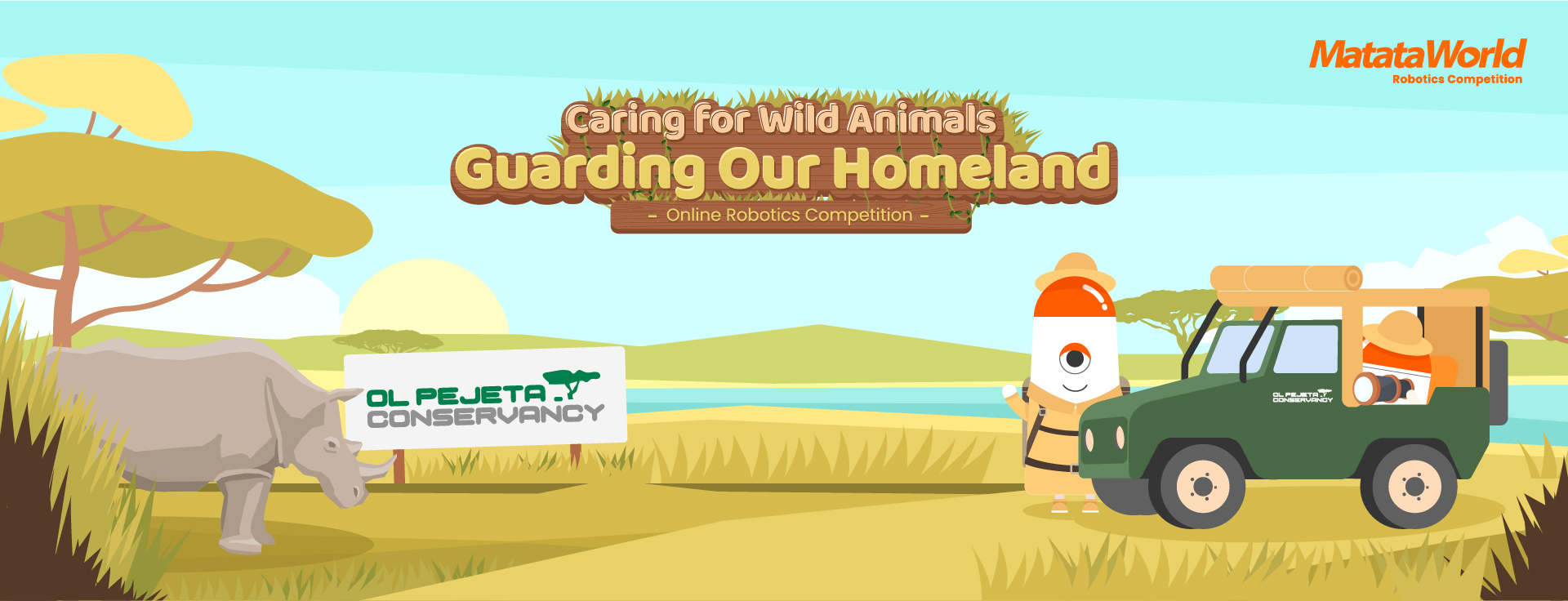
Task 1 : Finding Clack
Background:
Upon the invitation by World Animal Protection, MatataBot traveled to the Ol Pejeta Conservancy, home to some of the world's few rare rhinos, and will work with the local conservancy patrollers to complete a series of tasks.
First MatataBot and the patrollers will go to the grasslands to find and communicate with the star rhino Clack, who has been blinded by poaching. The purpose of this task is to make people aware of the harm poaching brings to animals.
Task:
-
Make a 5 x 5 grid map of the Ol Pejeta Conservancy (refer to the actual landscape of the Ol Pejeta Conservancy for creative design). Each grid should be 10cm x 10cm, and it is recommended to use the materials you already have at home to make the map. Set the graphic marker of the star rhino Clack at E5 and that of the workstation at A1.
-
Dress up MatataBot as a rhinoceros to better interact with the animal.
-
Use Matatalab's tangible coding and code MatataBot to start from workstation A1 and reach Rhino Clack at E5. Interact with Rhino Clack at E5 using the preset dance blocks.
-
The programming cannot be coded in segments, i.e. the robot needs to complete the entire task by pressing the Run button only once.
Score items:
-
Creative modification of robots and map design.
-
Successful departure from A1 workstation to E5 Rhino Clack (most of the robot's body shall be inside E5).
-
Execution of the pre-set dance module by the robot at E5.
-
The program is written in accordance with the requirements and fully optimized.
Reference Map:

Task 2 : Little Patroller
Background:
The second task of MatataBot is to carry out the daily patrol of the Conservancy together with the patrollers. Patrollers on the front line often struggle with poachers. They are protecting these endangered animals with their lives. It is hoped that the mission will make people realize the hardship of their work. Let's join the patrollers to protect these wild animals.
Task:
-
DIY a 5 x 5 map of the Ol Pejeta Conservancy, with the markers of lion, rhino, elephant, leopard, and chimpanzee at B2, B4, C3, D2, and D4, and the workstation at A1.
-
Dress up MatataBot as a patroller.
-
Code the Patroller MatataBot through tangible coding to pass through each of the five animal habitats from workstation A1 and eventually return to workstation A1.
-
The programming cannot be coded in segments, i.e. the robot needs to complete the entire task by pressing the Run button only once.
Score items:
-
Creative modification of robots and map design.
-
Successfully completing patrol missions through each animal habitat and eventually returning to the workstation.
-
The program is written in accordance with the requirements and fully optimized.
Reference Map:

Task 3 : Rescuing Baby Elephant
Background:
During a patrol, MatataBot found a tender and injured baby elephant. Due to the poachers' hunting, the baby elephant was separated from its mother. MatataBot needs to work with the patrollers to first escort the baby elephant back to the rescue station for treatment, and then help the baby elephant find its mother.
Task:
-
Use the DIY map from Task One or Task Two, or recreate a new map and place a self-made baby elephant diorama in the E3 grid.
-
Add relevant components to MatataBot so that it can be programmed to perform the function of transporting the baby elephant model. Materials such as Lego parts, magnets, and paper molds can be used.
-
MatataBot starts from A1, reaches E3 and transports the baby elephant model back to A1. The task is considered completed when the baby elephant model is completely inside the A1 grid.
Score items:
-
Creative modification of robots.
-
Completing the transport of the baby elephant model, i.e. starting from the starting point, reaching the task point and transporting the model back to the starting point.
-
Transport without human intervention.
Reference Map:

Materials Required:
-
Self-made grid maps of various sizes, with each grid measuring 10cm x 10cm. You are encouraged to make your own maps through painting.
-
Matatalab products.
-
Brushes, cardboard, glue paper, scissors, and other materials for making models and map decoration.
-
You are also encouraged to use paper crafts, clay, Lego parts, ice-cream sticks, and other materials to decorate MatataBot.